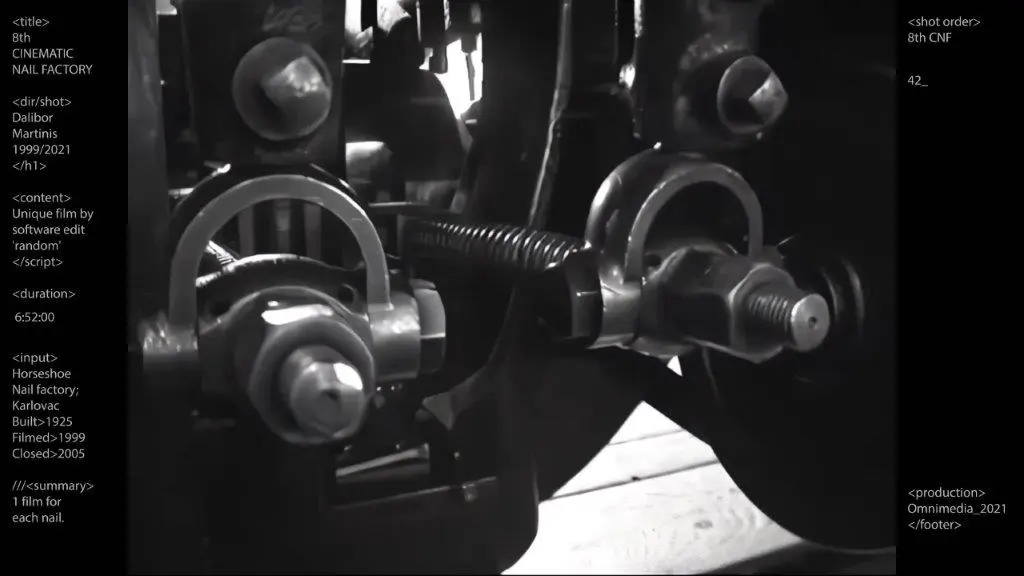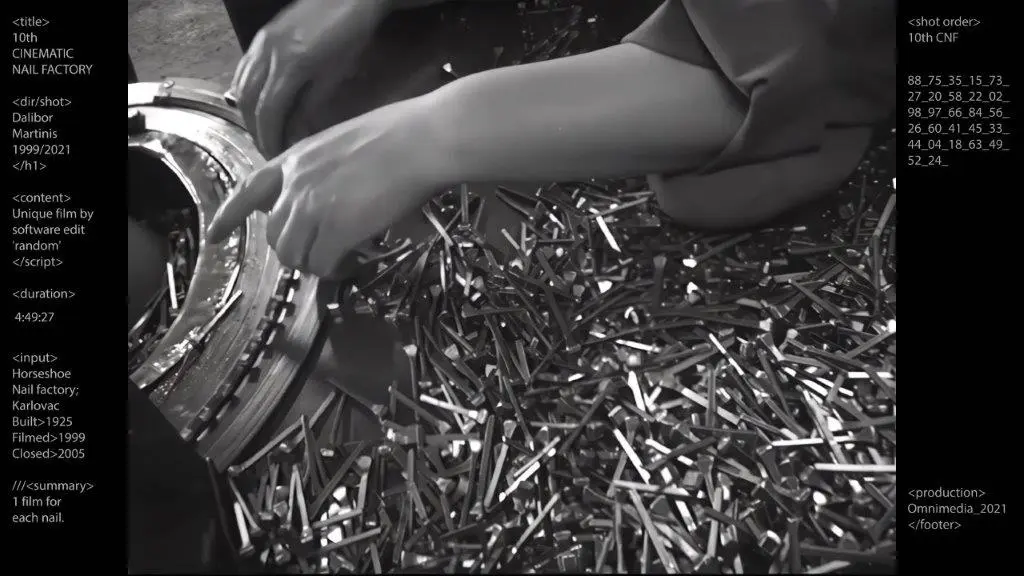Unique film(s) produced by software random editing
1999/2021-
6’54 min, b/w, sound
Shot, pre-edited and directed by Dalibor Martinis
Software development by Mihael Giba
Production: Omnimedia
Year of production: 2021
The title Nth Cinematic Nail Factory (2021) refers to countless possible variants of the film that Dalibor Martinis shot in 1999, in 99 frames, at the Karlovac factory producing horseshoe nails for horses, donkeys, and camels. The editing took place in 2021 and the factory, founded in 1925, ceased to exist in 2005. These years are an integral part of the film. In the 6 minutes and 54 seconds of its duration, they function as data visible on the vertical margins of the cinematic image, between which shots of the production process alternate accompanied by the repetitive sound of machines. Margins of cinematic images produced by digital technology are located in places usually reserved for perforations on the celluloid filmstrip, which are not visible to viewers during the film screening. The data written on the margins of Martinis’s cinematic image cannot be re[1]duced to the category of opening or closing credits, because they exist as an integral part of the film’s narrative. On the left margin, one sees the countdown to the moment when the image disappears, while on the right one there are ordinal numbers indicating changes of frames taken at the factory. On the left margin, along with information about the cinematographer and the director, there is a summary saying “1 film for each nail,” defining the content of the film as a “Unique film by software edit ‘random’.” Specified in this way, it raises the question of authorship, as it emphasizes the fact that it was a specific algorithm that determined the order of frames in editing, according to some logic known only to itself, and that the director did not participate in that selection, as well as that the possible number of combinations is practically infinite and that no film edited from the 99 shots made by Martinis is identical to any another film made from the same material.
The phrase cinematic factory in the title connotes the history of cinema. On the one hand, it refers to the first film screening held in Paris in 1895 – Workers Leaving the Lumière Factory in Lyon – and on the other Dziga Vertov’s masterpiece of avant-garde cinema Enthusiasm: The Symphony of Donbas, made in 1931 as a Soviet propaganda film. In the reference field of both films, there is the notion of industrialization as the foundation of modernity. Like industrial production, film is based on labour division and montage. Vertov’s film owes its enduring world fame primarily to the masterful editing of Yelizaveta Svilova. Ninety years later, in the post-industrial, digital age marked by deindustrialization and the consequent dismissal of workers due to factory liquidations, Dalibor Martinis has left the editor’s job to an algorithm. To a non-human entity.
In 1983, Vilém Flusser published his essay Towards Philosophy of Photography, in which he discussed the consequences of images produced by apparatuses. He called them technical images. In his view, the ancient magic of images is older than historical consciousness, while the new magic of technical images is “post-historical”. This magic of the second order, as Flusser calls it, conjures tricks with abstractions, because the function of technical images is to liberate their receivers from the necessity of thinking conceptually.1 Arguing that apparatuses were invented to simulate specific thought processes, Flusser exemplified the way in which thinking in numbers overrides historical thinking, whereby he identified Descartes as the originator of this tendency. It is since Descartes, he argues, that scientific thinking has tended towards the re-encoding of thoughts into numbers, but only since the camera has this tendency become materially possible. His conclusion is that the consequent mechanization of thinking will cause human beings to become less and less competent to deal with it and they will have to rely more and more on apparatuses.2
Since the late 1970s, or rather since the initial performance for the camera opening his anthological artwork Dalibor Martinis Talks to Dalibor Martinis, the focus of Martinis’s interest has been on the relationship between numerical and historical thinking. He has thus labelled his artworks with the umbrella term Data Recovery. With this term, ap[1]propriated from information technology, he has been exploring the modalities of reception and the possibilities of understanding certain visual contents in situations when they are extrapolated from the (historical) context within which they originated. The Nth Cinematic Nail Factory is likewise one of the variants in performing Data Recovery. This data recovery, in addition to the jargon of information technology, should be considered in the context of Freud’s Nachträglichkeit, a term that translates in English as deferred action. It indicates the relationship between the unconscious and trauma, in which there is an incursion of something called the enigmatic signifier. These enigmatic signifiers are sort of “hieroglyphs” that keep addressing us in a way, creeping under our psychic skin even though we no longer have the key to their meaning. The Nth Cinematic Nail Factory exposes its viewers to these very “hieroglyphs”, calling for an attempt to decipher them. An attempt at conceptual, historical thinking despite the dictatorship of numerical (non)thinking.

Leonida Kovač, Zagreb, April 2022
(Translated by Marina Schumann)
1 Vilém Flusser, Towards a Philosophy of Photography, trans. Anthony Mathews (London: Reaktion Books, 2000), p. 17.
2 Ibid., pp. 31-32

Leonida Kovač
Theoretician, curator, and lecturer at the Department of Art Theory, Academy of Fine Arts in Zagreb. Author of the following books: Contexts (Meandar, Zagreb, 1997), Codes of Identity (Meandar, Zagreb, 2001), Edita Schubert (Horetzky, 2001), Relations of the Reality (Meandar, Zagreb, 2007), Inventing Yourself: Gorki Žuvela (Gliptoteka HAZU, Zagreb, 2009), Anonimalia: Normative Discourses and Self-Presentations of Women Artists of the 20th Century (Antibarbarus, Zagreb, 2010).

